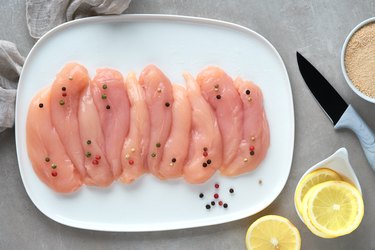
As defined by the United States Department of Agriculture, the chicken tenderloin is a strip of muscle distinct from but lying alongside the inner breast of the chicken closest to the bone. Even though the USDA has a definition for the tenderloin, it's not official (meaning enforceable), so learn to recognize this tender piece of the chicken.
About the Tenderloin
Video of the Day
The tenderloin is high in protein. The amount of chicken tenderloin protein content is about 22 grams of protein per 3.5-ounce serving, while the breast meat as a whole has 19.5 grams in the same serving size.
Video of the Day
The tenderloin is roughly oblong and tapered with a tell-tale white tendon running down its length. This tendon should be removed before cooking.
Although the tenderloin is generally acknowledged as the most tender part of the chicken because it has been exercised less than the larger breast muscle, keep in mind that the chicken you're having for dinner most likely came to market at the age of one or two months or under. None of the bird's breast muscles ever got much of a workout to begin with.
How to Remove the Tough Tendon
Seize the protruding white knob of gristle at the top wide end of the tenderloin, pierce the meat with a fork with tines on either side of the tendon to stabilize it and then tug the tendon loose through the tines. For better traction, use a paper towel to get a good grip on the tendon.
Another approach is to press a sharp boning knife alongside the length of the tendon and tease it out as you pull the tendon loose from the knobby end.
Poaching or Steaming the Tenderloin
There are several simple, healthy and customizable methods of cooking the tenderloin. Poach the chicken in simmering seasoned water or broth. Let the liquid cook down but not to the point of evaporation for tender, moist chicken. This method is especially good for chicken salad.
Place the chicken in a steamer or steaming basket over high heat. If you like, add in bite-sized vegetable pieces. It should only take about 10 minutes or so to cook everything through, and the chicken will retain its moisture.
Baking the Tenderloin
There are plenty of baked chicken tenderloin recipes. To keep it tender, use dairy-based marinade beforehand. Bake only until it browns and the internal temperature reaches 165 degrees Fahrenheit. Be careful not to overcook it.
For crispy baked chicken tenders, marinate them in yogurt or buttermilk for about half an hour ahead of time. Roll them in panko breadcrumbs and bake on a cookie sheet at 425F for about 20 minutes, turning them over once midway through the cooking time.
Another way to bake chicken tenders without losing moisture is to wrap them in parchment. Place the chicken in the middle of a square of kitchen parchment, gather the edges, twist it up and tie it with twine. You can add some bite-sized vegetable pieces for added flavor.
Cutlets on a Budget
You can buy a plastic-wrapped package of tenderloins at the supermarket for about the same price as a package of regular chicken breast that has been sliced into cutlets.
If you're on a budget, consider slicing your own cutlets using regular breast meat. Boneless, skinless breasts are usually cheaper than precut, and bone-in breasts with rib meat are cheaper still. Go to your supermarket's website and compare price per pound before you go shopping. Chicken breast in most forms is often on sale in any case.
Chicken Tenders, Fingers and Strips
The breaded, fried chicken fingers, strips or tenders beloved by children and found in the frozen foods aisle of the supermarket or at fast-food joints probably aren't the tenderloin (unless it's specifically stated on the package). They're more likely to be random strips of breast meat. If you like, you can make your own quite easily. The kids will gobble them up, and you'll come in under budget.
When you cut chicken breast into thin strips, it will take a bit longer to cook than the tenderloin on its own. Since the breast meat is a little tougher than the tenderloin, you may want to take a meat mallet to it first. Remove the bone beforehand or just use boneless, skinless breast. Cover the meat with plastic wrap as you pound to prevent bits of meat from spattering.
Cut the chicken breast into strips, marinate in buttermilk for half an hour in the fridge, dredge in seasoned flour, dip it into a few beaten eggs and then dredge it once more in the flour. You can use breadcrumbs for the last dredging if you like. Fry it in small batches in hot vegetable oil. Drain it on paper towels.